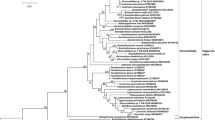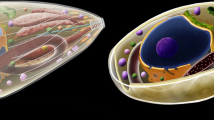Abstract
The localisation and distribution of the cytoskeletal protein tubulin in the adult liver flukeFasciola hepatica have been determined by an indirect immunofluorescence technique using a monoclonal antibody raised against β-tubulin. Tubulin was demonstrated in the tegumental syncytium and in the tegumental cell bodies and their cytoplasmic connections with the surface syncytium. Immunostaining was also evident in the nerve fibres innervating sensory receptors in the tegument, in the nerve plexus innervating the sub-tegumental musculature and in the cytoplasmic extensions of the nurse cells within the vitelline follicle. Immunoblotting of whole fluke fractions produced a single band corresponding to a molecule of approximately 54 kDa in size. This figure corresponds with previous data obtained on tubulin from other helminth and eukaryotic sources.
Similar content being viewed by others
References
Allen RD (1987) The microtubule as an intracellular engine. Sci Am 256:26–33
Atkinson C, Newsam RJ, Gull K (1980) Influence of the antimicrotubule agent, mebendazole, on the secretory activity of intestinal cells ofAscaridia galli. Protoplasma 105:69–76
Avila J (1990) Microtubule dynamics. FASEB J 4:3284–3290
Bennett CE, Threadgold LT (1975)Fasciola hepatica: development of tegument during migration in mouse. Exp Parasiol 38:38–55
Bennett JL, Köhler P (1987)Fasciola hepatica: action in vitro of triclabendazole on immature and adult stages. Exp Parasitol 63:49–57
Boray JC (1986) Trematode infections of domestic animals. In: Campbell WC, Rew RS (eds) Chemotherapy of Parasitic Diseases, ch 20. Plenum Press, New York London, pp 401–425
Borgers M, De Nollin S, De Brabander M, Thienpont D (1975a) Influence of the anthelmintic mebendazole on microtubules and intracellular organelle movement in nematode intestinal cells. Am J Vet Res 36:1153–1166
Borgers M, De Nollin S, Verheyen A, Vanparijs O, Thienpont D (1975b) Morphological changes in cysticerci ofTaenia taeniaeformis after mebendazole treatment. J Parasitol 61:830–843
Chalfic M, Thomson JN (1982) Structural and functional diversity in the neuronal microtubules ofCaenorhabditis elegans. J Cell Biol 93:15–23
Cleveland DW (1987) The multitubulin hypothesis revisited: what have we learned? J Cell Biol 104:381–383
Coons AH, Leduc EH, Connolly JM (1955) Studies on antibody production. I. A method for the histochemical demonstration of specific antibody and its application to a study of the hyperimmune rabbit. J Exp Med 102:49–60
Danowski BA (1989) Fibroblast contractility and actin organization are stimulated by microtubule inhibitors. J Cell Sci 93:255–266
Davis AH, Blanton R, Klich P (1985) Stage and sex specific differences in actin gene expression inSchistosoma monsoni. Mol Biochem Parasitol 17:289–298
Davis C, Gull K (1983) Protofilament number in microtubules in cells of two parasitic nematodes. J Parasitol 69:1094–1099
Dustin P (1984) Microtubules, 2nd edn. Springer, Berlin Heidelberg New York
Fetterer RH (1986) The effect of albendazole and triclabendazole on colchicine binding in the liver flukeFasciola hepatica. J Vet Pharmacol Ther 9:49–54
Gotlieb AI, May LMcB, Subrahmanyan L, Kalmins VI (1981) Distribution of microtubule organizing centers in migrating sheets of endothelial cells. J Cell Biol 91:589–594
Gull K, Dawson PJ, Davis C, Byard EH (1987) Microtubules as target organelles for benzimidazole anthelmintic chemotherapy. Biochem Soc Trans 15:59–60
Hanna REB, Trudgett AG (1983)Fasciola hepatica: development of monoclonal antibodies and their use to characterize a glycocalyx antigen in migrating flukes. Parasite Immunol 5:409–425
Irwin SWB, Threadgold LT (1970) Electron-microscope studies onFasciola hepatica VIII. The development of the vitelline cells. Exp Parasitol 28:399–411
Kassai T, Takáts C, Fok É, Redl P (1988) Activity of luxabendazole against liver flukes, gastrointestinal roundworms, and lungworms in naturally infected sheep. Parasitol Res 75:14–18
Kelly RB (1990) Microtubules, membrane traffic, and cell organization. Cell 61:5–7
Lacey E (1988) The role of the cytoskeletal protein, tubulin, in the mode of action and mechanism of drug resistance to benzimidazoles. Int J Parasitol 18:885–936
Lacey E (1989) Comparative biochemistry of parasites and its role in drug resistance — an investigation of species differences in tubulin. In: Bennet E-M, Behm C, Bryant C (eds) Comparative Biochemistry of Parasitic Helminths, ch 12. Chapman and Hall, London New York, pp 145–167
Lackie JM (1986) Cell movement and cell behaviour. Allen and Unwin, London
Laemmli UK (1970) Cleavage of structural proteins during the assembly of the head of bacteriophage T4. Nature 227:680–685
MacGregor AN, Shore SJ (1990) Immunocytochemistry of cytoskeletal proteins in adultSchistosoma mansoni. Int J Parasitol 20:279–284
McGuire J, Moellmann G (1972) Cytochalasin B: effect on microfilaments and movement of melanin granules within melanocytes. Science 175:642–644
McIntosh JR, Koonce MP (1989) Mitosis, Science 246:622–628
Mogensen MM, Tucker JB, Stebbings H (1989) Microtubule polarities indicate that nucleation and capture of microtubules occurs at cell surfaces inDrosophila. J Cell Biol 108:1445–1452
Morris GP, Threadgold LT (1968) Ultrastructure of the tegument of adultSchistosoma mansoni. J Parasitol 54:15–27
Osborn M, Weber K (1976) Cytoplasmic microtubules in tissue culture cells appear to grow from an organizing structure towards the plasma membrane. Proc Natl Acad Sci USA 73:867–871
Pollard TD, Cooper JA (1986) Actin and actin-binding proteins. A critical evaluation of mechanisms and functions. Annu Rev Biochem 55:987–1035
Rubino S, Fiori PL, Lubinu G, Monaco G, Cappuccinelli P (1983) The cytoskeleton of hydatid cyst cultured cells and its sensitivity to inhibitors. Eur J Cell Biol 30:182–190
Schliwa M (1986) The Cytoskeleton. An Introductory Survey. Springer, Vienna Berlin Heidelberg New York
Sharma S, Abuzar S (1983) The benzimidazole anthelmintics —chemistry and biological activity. Prog Drug Res 27:85–161
Soifer D (1986) Dynamic Aspects of Microtubule Biology, vol 466. New York Academy of Sciences, New York
Stitt AW, Fairweather I, Trudgett AG, Johnston CF, Anderson SML (1991) Localisation of actin in the liver fluke,Fasciola hepatica. Parasitol Res (in press)
Sullivan KF (1988) Structure and utilization of tubulin isotypes. Annu Rev Cell Biol 4:687–716
Tang L, Prichard RK (1988) Comparison of the properties of tubulin fromNippostrongylus brasiliensis with mammalian brain tubulin. Mol Biochem Parasitol 29:133–140
Tang L, Prichard RK (1989) Characterization of tubulin fromBrugia malayi andBrugia pahangi. Mol Biochem Parasitol 32:145–152
Towbin H, Staehelin T, Gordon J (1979) Electrophoretic transfer of proteins from polyacrylamide gels to nitrocellulose sheets. Procedure and some applications. Proc Natl Acad Sci USA 76:4350–4354
Traas JA, Burgain S, Dumas de Vaulx R (1989) The organization of the cytoskeleton during meiosis in eggplant (Solanum melongena (L.)): microtubules and F-actin are both necessary for coordinated meiotic division. J Cell Sci 92:541–550
Vale RD (1987) Intracellular transport using microtubule-based motors. Annu Rev Cell Biol 3:347–378
Van den Bossche H, Rochette F, Hörig C (1982) Mebondazole and related anthelmintics. Adv Pharmacol Chemother 19:67–128
Verheyen A, Borgers M, Vanparijs O, Thienpont D (1976) The effects of mebendazole on the ultrastructure of cestodes. In: Van den Bossche H (ed) Biochemistry of Parasites and Host-Parasite Relationships. Elsevier/North-Holland, Amsterdam pp 605–618
Watts SDM (1981) Colchicine binding in the rat tapeworm,Hymanolepis diminuta. Biochim Biophys Acta 667:59–69
Author information
Authors and Affiliations
Rights and permissions
About this article
Cite this article
Stitt, A.W., Fairweather, I., Trudgett, A.G. et al. Fasciola hepatica: localization and partial characterization of tubulin. Parasitol Res 78, 103–107 (1992). https://doi.org/10.1007/BF00931649
Accepted:
Issue Date:
DOI: https://doi.org/10.1007/BF00931649




